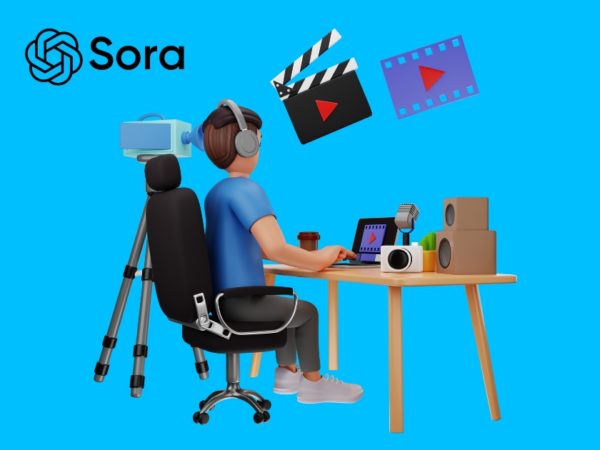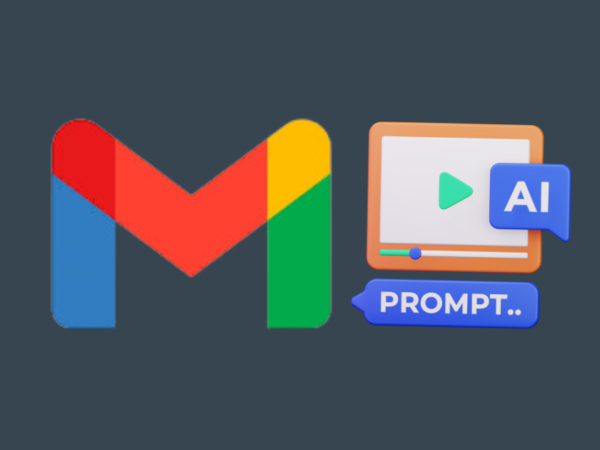<img alt="Best AI Tools Every Teacher Needs in Their Arsenal" data- data-src="https://kirelos.com/wp-content/uploads/2023/09/echo/Best-AI-Tools-Every-Teacher-Needs-in-Their-Arsenal.jpg/w=800" data- decoding="async" height="420" src="data:image/svg xml,” width=”800″>
Honestly, teachers don’t have it as easy as we usually imagine during our time as students. I am sure some AI tools for teachers can greatly help to make day-to-day tasks easier.
Creating lessons, tracking student progress, grading assignments, generating insights from data, and coming up with new activities aren’t easy tasks. Thankfully, you can get help from AI tools to not only automate these tasks but also perform them in a better way.
Here is a quick summary of the best AI tools for teachers I’ll be discussing below.
AI Tool
Notable Features
Link
Yippity
Automates quiz creation, editing options.
SlidesAI
AI Google Slides presentation maker from text
Winston AI
Detects AI plagiarism, OCR text extraction
ChatGPT
AI assistance for teaching tasks, lesson plans
Formative
AI-assisted quiz creation, class management
Fobizz
AI tools for teachers, transcription, grading
Roshi
Lesson generation from text, dialogue creation
EssayGrader
Auto-grades essays, custom rubrics
In this article, I am listing some of the best AI tools for teachers that will turn hours of work into minutes.
Yippity
Although a very simple tool, Yippity automates one of the most important parts of teaching; assessments. The tool helps teachers automatically create questions/answers quiz from any lesson. All you have to do is copy/paste the notes or provide a URL if the topic is available online.
For each topic, it will generate about 20 questions along with their answers. You can edit the questions and answers before copying them and even delete the ones you don’t want.
Unfortunately, it doesn’t have some of the advanced features that manual quiz builder apps have; you’ll have to manually copy the results and paste them into your quiz app/form.
You can create up to 3 quizzes/month for free. For unlimited quizzes, you’ll have to subscribe to the paid plan for $4.99.
SlidesAI
Creating presentations is another necessary task for educators to break down complex topics to make them easy to understand. SlidesAI is an AI presentation maker that makes this process automatic by helping you create beautiful slides just from text.
<img alt="YouTube video" data-pin-nopin="true" data-src="https://kirelos.com/wp-content/uploads/2023/09/echo/maxresdefault.jpg650c20402db82.jpg" height="720" nopin="nopin" src="data:image/svg xml,” width=”1280″>
It comes as a Google Slides extension, and all the presentations will be created in Google Slides. To create a presentation, all you have to do is choose a theme and presentation nature and then provide the text. It will understand the text and automatically create slides that best fit the text and also add images matching the text.
There is also an option to create a presentation using an AI writing tool instead. You’ll just need to provide the topic name and what you want to talk about in it. SlideAI will automatically create the presentation and fill in the text in it. You’ll get to create 3 presentations of 2500 characters each for free in a month.
Winston AI
With the advent of AI writing tools, plagiarism has become a major problem, as detecting AI plagiarism is quite difficult. As a teacher, Winston AI can help you detect both online plagiarism and AI plagiarism. By keeping up with the latest LLM updates, this tool uses AI knowledge against AI writing tools.
Winston AI claims to detect AI writing with up to 99.6% accuracy. You can either copy/paste the text or upload a document for scanning. You can even upload an image, and it will use its own OCR tool to extract and scan the text.
In the free version, you can scan up to 2000 words, but online content plagiarism detection isn’t available. The paid plans increase the word count and offer advanced features like online content plagiarism detectors and detailed reporting.
Alternatively, you can also try Copyleaks, which can be great for advanced users as it has more customization options.
ChatGPT
ChatGPT API is the source for many amazing features these AI tools offer. However, you can also access ChatGPT directly and use it to get help with teaching needs. You can utilize ChatGPT prompts, extensions, and plugins, or just directly ask ChatGPT for whatever you need help with.
To get you started, below I am listing some ways ChatGPT can be useful for teachers:
- Create lesson plans and ideas.
- Create sample questions and solutions from the topic.
- Get ideas to implement the latest technologies as per your class needs.
- Learn personalized classroom management strategies.
- Explain complex concepts in simple terms based on the level of the students.
- Get ideas for in-class activities that could help you understand a topic.
- Get advice to help tackle the specific needs of individual students.
- Get feedback on student assignments and even grade them.
Other than this in-class help, ChatGPT can also help you become a better teacher by helping you understand your career scope, learn more about your main subject, or just get motivational quotes.
Although ChatGPT 3.5 is free to use with unlimited access, you need to get ChatGPT Plus to access the latest GPT 4.0 model and advanced features like plugin support. Furthermore, there are also many ChatGPT alternatives that can offer similar help, such as Google Bard, which has arguably deeper academic knowledge.
Formative
Formative helps you both manage your class and create new lessons and activities. Although you can manually create and manage lessons, I am going to focus on it’s AI features only. The tool lets you automatically create quizzes and activities using AI, including multiple choice, true/false, matching, short answers, and more.
<img alt="YouTube video" data-pin-nopin="true" data-src="https://kirelos.com/wp-content/uploads/2023/09/echo/maxresdefault.jpg650c204077595.jpg" height="720" nopin="nopin" src="data:image/svg xml,” width=”1280″>
You can choose grade levels from kindergarten to university and up to 70 subjects. Afterward, create a prompt talking about what the quiz should be about and if you have any specific requests. You can also choose the difficulty of the test, which will increase/decrease while still being within the limits of the grade level selected.
Once created, you can further edit the assessment and even regenerate parts that you don’t like. You can even ask Formative to create hints for each question to make it easier for students to answer.
In the Classes section of the tool, you can manage all the classes you have and add your students (using a unique link) to share work and track their progress. They can answer the assessments inside Formative, and it will automatically grade the test according to their answers.
Best of all, the free version lets you create unlimited assessments and lessons, and you can also create classes and track student progress. The paid plans only add advanced features like auto-grading, anti-cheating, collaboration, etc.
Fobizz
Fobizz is basically a bunch of AI and other regular tools in one place, and all of them are specifically created to help teachers and students.
Below I am listing it’s AI tools that are created for teachers:
Chat with AI: It’s a chatbot like ChatGPT but has built-in prompts to help with specific teaching tasks or play a specific role. This includes creating assessments, and lessons, summarizing content, providing feedback on text, etc.
AI Image Generator: A quick AI image generator using text input. It can be useful for teachers to get images to explain complex data or create a presentation.
AI Transcription: You can either upload an audio/video file or copy/paste a YouTube or Vimeo link for this to transcribe and then use AI to ensure the content makes sense.
AI PDF Chat: A simple tool where you can upload a PDF or a text document and ask questions about it or get help. It can be great for getting feedback and help with assignments completed by students.
AI Grading Assistant: You can provide grading scale type, expected solution, and the student assignment, and this tool will provide complete feedback on how the student did.
Other than these, there are a bunch of other tools that can help teachers, and some even have minor AI functionalities. Some of these include a word cloud generator, QR code generator, file sharing tool, teaching board, survey creator, AI text editor, and a few more.
The tools are free to use for now, but you’ll have to sign up to use them. Your account is also used to view previously saved work on these tools.
Roshi
If you want something simple to generate lessons from text or from scratch, Roshi does a great job. Although it can also generate activities for assessment, I am putting it here for its lesson-creation features. You can ask it to generate a story about almost anything with a specific moral, and it will not only generate a story but also add AI-generated images related to the story.
You can also generate a one-on-one dialogue based on specific circumstances, and it will create a detailed dialogue with real-world possible scenarios.
If you don’t want to generate AI content from scratch, you can give it your own text or link to an article or video to create a lesson around it. It can summarize that content with preferred difficulty, create a vocabulary list, generate a quiz, or discuss the content and its theme.
Its free version is limited to only 5 lessons per month; the Pro subscription gives unlimited access to all features and up to 1,500-word prompts support.
EssayGrader
EssayGrader automatically grades student essays and provides detailed feedback. You can provide the essay as text or a PDF file, and it will scan it based on its own rubrics. Along with the overall grade, it will give feedback on essay organization, word choice, introduction, vocabulary, and sensory details.
You can choose an essay grade level from elementary up to college, and also its tone like persuasive or narrative. If that’s not enough, you can also create your own rubrics by selecting the Use my custom rubrics option. The custom rubrics can be defined in natural language, and you can create up to 8 rubrics.
Other than grading, it also helps summarize long essays and detect AI-written content. You can grade 10 essays per month in the free version up to 1000 words each. The Pro plans will increase the monthly essay count and allow you to use the AI detection feature.
Wrapping Up
All of these tools will help streamline lesson creation, assessment, and grading process. Do remember that AI isn’t perfect; it can and will make mistakes. Make sure you edit the results later to ensure they are perfect for use and there are no errors. Thankfully, most of these tools let you edit the end results in their own interface, so editing shouldn’t be an issue.
You may also explore some best AI-based Chrome Extensions for better productivity.



